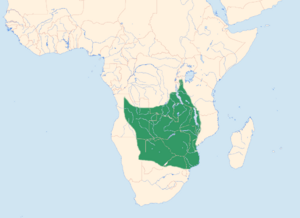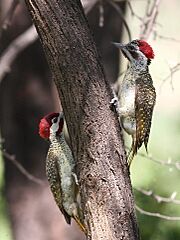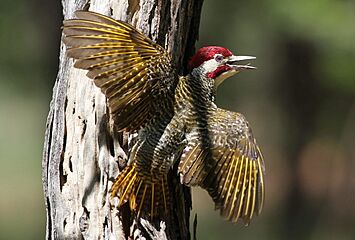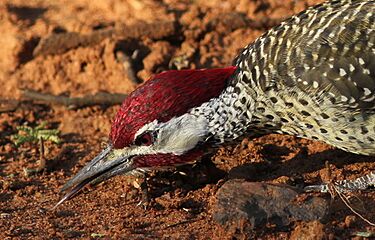Bennett's woodpecker facts for kids
Quick facts for kids Bennett's woodpecker |
|
|---|---|
 |
|
| male | |
| Conservation status | |
| Scientific classification | |
 |
|
| Year-round range |
The Bennett's woodpecker (Campethera bennettii) is a cool bird that belongs to the woodpecker family. You can find these birds living in the woodlands and bushy areas of Africa. Good news! Experts from the International Union for Conservation of Nature (IUCN) say this species is not in danger of disappearing.
Contents
About Its Name
A scientist named Andrew Smith first described this woodpecker in 1836. Its name, Bennett's woodpecker, honors a British nature expert named Edward Turner Bennett.
There are two slightly different types, or subspecies, of Bennett's woodpecker. They are called Campethera bennettii bennettii and C. b. capricorni.
What It Looks Like
The Bennett's woodpecker is about 24 cm (9.4 in) long. That's about the length of a school ruler! It weighs between 61–84 g (2.2–3.0 oz).
Male woodpeckers have a red forehead, the top of their head, and the back of their neck. Their chin and throat are white. The upper parts of their body are a mix of brown, yellow, and white. Their belly and chest are pale yellow with dark spots. They have red eyes, a gray beak, and bluish-green or gray-green legs.
Female woodpeckers look a bit different. They have a black forehead with white spots. Their cheeks and throat are brown or blackish-brown. Young woodpeckers have a black forehead and crown, and their upper parts are darker.
The capricorni subspecies is a little bigger. Its underparts are a deeper yellow color and have fewer spots.
Where It Lives
This woodpecker lives in many countries across Africa. You can find it in places like Angola, Botswana, South Africa, Tanzania, and Zambia. It doesn't live everywhere in these countries, but in specific areas.
It likes to live in woodlands and bushy areas. This includes forests with trees like miombo, Baikiaea, Acacia, and mopane trees.
How It Behaves
Bennett's woodpeckers can be seen alone, in pairs, or in small family groups. They spend most of their time looking for food on the ground. They prefer bare ground or areas with short grass. They also look for food in trees.
Their favorite foods are ants and termites, including their eggs.
These woodpeckers make different sounds. Some of their calls include "chuur" notes or a series of "wi-wi-wi-wi" sounds. They also make "kee-kee-kee" or "ddrahh, ddrahh, ddray-ay, ddray-ay" calls. Sometimes, you might hear a chattering "wirrit-wirrit" sound.
They usually breed between August and February. The woodpeckers either dig new holes in trees or use old ones to lay their eggs. A female woodpecker lays three eggs. The parents then sit on the eggs for 15 to 18 days until they hatch.
Its Conservation Status
The number of Bennett's woodpeckers in the wild is stable. This means their population is not going down. There are no major threats to this species. Because of this, the IUCN has decided that it is a "least-concern species". This means it is not currently at risk of extinction.
Gallery






